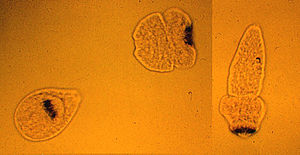Neodermata
| Neodermata | ||||||||
|---|---|---|---|---|---|---|---|---|

The Helicometra suction worm , which lives in the digestive tract of cardinalfish . |
||||||||
| Systematics | ||||||||
|
||||||||
| Scientific name | ||||||||
| Neodermata | ||||||||
| Ehlers , 1985 |
The Neodermata (from ancient Greek néos 'new' and δερμα 'skin', literally new skin ) is a taxon that combines three classes of flatworms, namely the tapeworms (Cestoda), the hooked worms (Monogenea) and the flukes (Trematoda) with the Digenea and the Aspidobothrii . With the exception of the monogenea, which are aquatic ectoparasites with direct development, these animals live exclusively endoparasitic and are accordingly adapted to the way of life inside other animals.
features
The Neodermata represent a very diverse group within the flatworms and can differ greatly in their habitus and body size. While many species are only a few millimeters or centimeters long, some types of tapeworms can reach body lengths of several meters.
The eponymous and characteristic feature of this group is the formation of a neodermis in the first parasitic larval form. This is a "secondary body covering", which consists of cells of mesodermal origin and replaces the original epidermis . This happens through larval already existing mesoderm tissue, which pushes through runners under the epidermis and detaches it. The individual cells of the neodermis then fuse to form a uniform tissue without cell boundaries, which is referred to as the syncytium and in which the cell nuclei lie further inside the body, below the basal matrix .
Another basic feature of the neodermata is a suction cup on the head end.
development
The neodermata form so-called composite ectolecithale eggs, in which an egg cell and a yolk cell as well as a sperm from a receptaculum seminis are covered and fertilized by an egg shell. Embryonic development begins either in the uterus or outside the body.
Ciliated larvae hatch from the eggs, which differ depending on the animal group. The larva of Diginea is known as Miracidium , while that of Aspidobothrii is known as Cotylocidium , that of Monogenea as Oncomiracidium , that of Gyrocotylidea and Amphilinidea as Lycophoral larva, and that of Diphyllobothriidae as Coracidium . The larvae must invade the first host within the first 24 to 48 hours or die. When entering the host, the first larvae shed their original epidermis and it can take several hours to days before a complete neodermis is formed.

The individual taxa differ in further development. While most Monogenea and Aspidobothrii become sexually mature in the first host , most Neodermata require at least one, often several, host changes . The larvae change during this host change and often develop special structures such as glands or spines that allow them to penetrate a new host. These species only develop their sexual organs in the ultimate host and become sexually mature.
In some species, asexual reproduction occurs during development in the form of a generation change, such as in the Diginea in the form of the daughter sporocysts and the Redia or in the Echinococcus species, to which the fox tapeworm belongs, through the formation of buds in a hydatide .
Systematics
As a monophyletic taxon, the Neodermata include the following classes of flatworms:
- Tapeworms (Cestoda)
- Hook worms (Monogenea)
- Flukes (Trematoda)
The latter include the Digenea and the Aspidobothrii .
supporting documents
- ↑ a b c d e f Willi Xylander : Neodermata , in: W. Westheide, R. Rieger (Ed.): “ Special Zoology Part 1: Protozoa and Invertebrates ”; Gustav Fischer Verlag, Stuttgart, Jena 1996: p. 230 ff .; ISBN 3-437-20515-3 .
literature
- Willi Xylander : Neodermata , in: W. Westheide, R. Rieger (Ed.): “ Special Zoology Part 1: Protozoa and Invertebrates ”; Gustav Fischer Verlag, Stuttgart, Jena 1996: p. 230 ff .; ISBN 3-437-20515-3 .